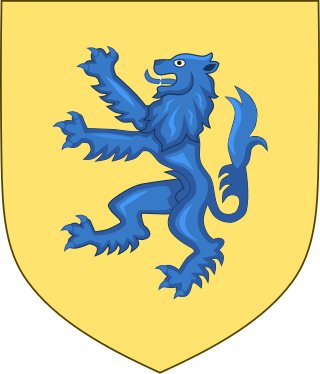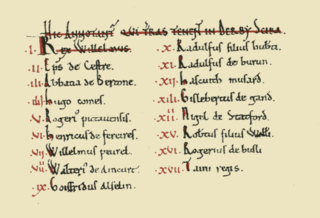Related Research Articles

William de St-Calais was a medieval Norman monk, abbot of the abbey of Saint-Vincent in Le Mans in Maine, who was nominated by King William I of England as Bishop of Durham in 1080. During his term as bishop, St-Calais replaced the canons of his cathedral chapter with monks, and began the construction of Durham Cathedral. In addition to his ecclesiastical duties, he served as a commissioner for the Domesday Book of 1086. He was also a councillor and advisor to both King William I and his son, King William II, known as William Rufus. Following William Rufus' accession to the throne in 1087, St-Calais is considered by scholars to have been the new king's chief advisor.

The Percy family is an ancient English noble family. They were among the oldest and most powerful noble families in Northern England for much of the Middle Ages. The noble family is known for its long rivalry with the House of Neville, another family powerful in northern England during the 15th century. The feud between the two families, known as the Percy-Neville feud led to the Wars of the Roses, at the time known as the Civil Wars, in England.
William of Aldrie was a first generation Anglo-Norman and rebel. A cousin of, and steward to, William of Eu, he was executed in January 1096.

Stephen Etienne of Aumale was Count of Aumale from before 1089 to 1127, and Lord of Holderness.
Juhel de Totnes, Latinised to Judhellus filius Aluredi, "Juhel son of Alured") was a soldier and supporter of William the Conqueror (1066–1087). He was the first feudal baron of Totnes and feudal baron of Barnstaple, both in Devon.

The House of Braose was a prominent family of Anglo-Norman nobles originating in Briouze, near Argentan, Orne, Normandy. Members of this family played a significant part in the Norman conquest of England and subsequent power struggles in England, Wales and Ireland in the 11th to 14th centuries.

William I (Willame) de Percy, 1st feudal baron of Topcliffe in North Yorkshire, known as Willame als gernons, was a Norman nobleman who arrived in England immediately after the Norman Conquest of 1066. He was the founder via an early 13th-century female line of the powerful English House of Percy, Earls of Northumberland, and via an 18th-century female line of the Dukes of Northumberland.
Richard fitz Eustace was Constable of Chester and Baron of Halton within the County Palatine of Chester ruled by the Earl of Chester.
William de Courcy, feudal baron of Stoke Courcy in Somerset, was an Anglo-Norman nobleman.
William Meschin was an Anglo-Norman nobleman and baron. The brother of the earl of Chester, Meschin participated in the First Crusade. After returning to England, he acquired lands both from King Henry I of England and by his marriage to an heiress.
Hasculf de Tany was an Anglo-Norman nobleman who lived in medieval England, in the region of London. He is believed to have been castellan of the Tower of London.

The feudal barony of Okehampton was a very large feudal barony, the largest mediaeval fiefdom in the county of Devon, England, whose caput was Okehampton Castle and manor. It was one of eight feudal baronies in Devonshire which existed during the mediaeval era.

The Domesday Book of 1086 lists in the following order the tenants-in-chief in Devonshire of King William the Conqueror:

The feudal barony of Appleby was a feudal barony with its caput at Appleby Castle in Appleby, Westmorland, England.
Robert, Count of Eu and Lord of Hastings, son of William I, Count of Eu, and his wife Lesceline. Count of Eu and Lord of Hastings.
Hugh de Beauchamp was a Norman who held lands in England after the Norman Conquest.

John fitz Richard was an Anglo-Norman soldier, Baron of Halton and hereditary Constable of Chester. Historical records refer to him as "John, Constable of Chester". He died at Acre in the Holy Land.

The Constable of Chester was a mediaeval hereditary office held by the Barons of Halton. The functions of the Constable are unclear, possibly they related to the custody of Chester Castle, as was the main function of most mediaeval constables, but Sanders (1960) says the office-holder was constable for the entire County Palatine.

The Domesday Book of 1086 AD lists King William the Conqueror's tenants-in-chief in Derbyscire (Derbyshire), following the Norman Conquest of England:
Nigel Fossard was an Anglo-Norman nobleman who held the honour of Mulgrave in Yorkshire and by virtue of that is considered the feudal baron of Mulgrave.
References
- 1 2 3 4 5 6 7 8 Sanders 1960, p. 119.
- 1 2 3 Barlow 2000, p. 357.
- ↑ Cownie 1998, p. 213.
- ↑ Sanders 1960, p. 147.